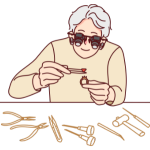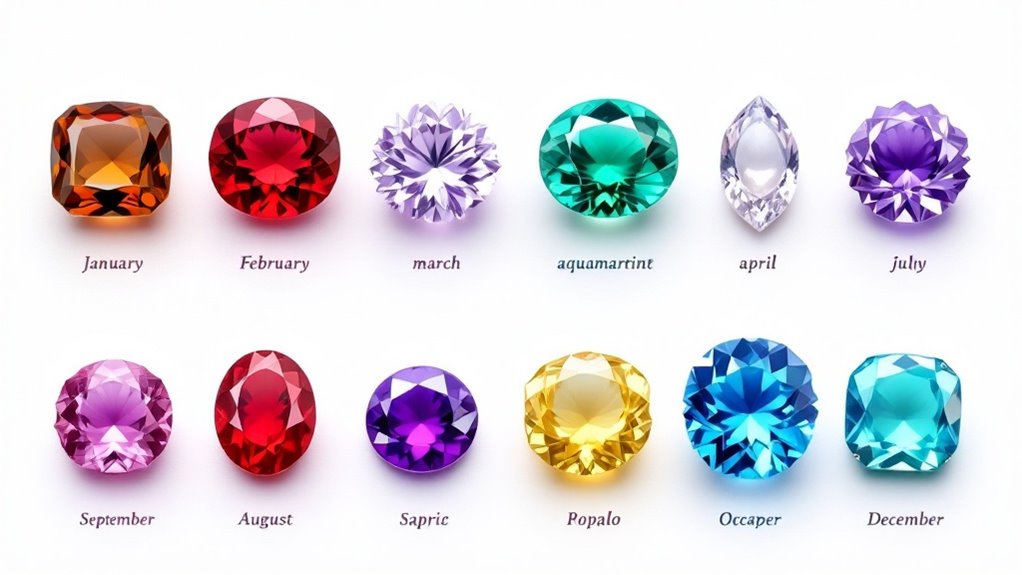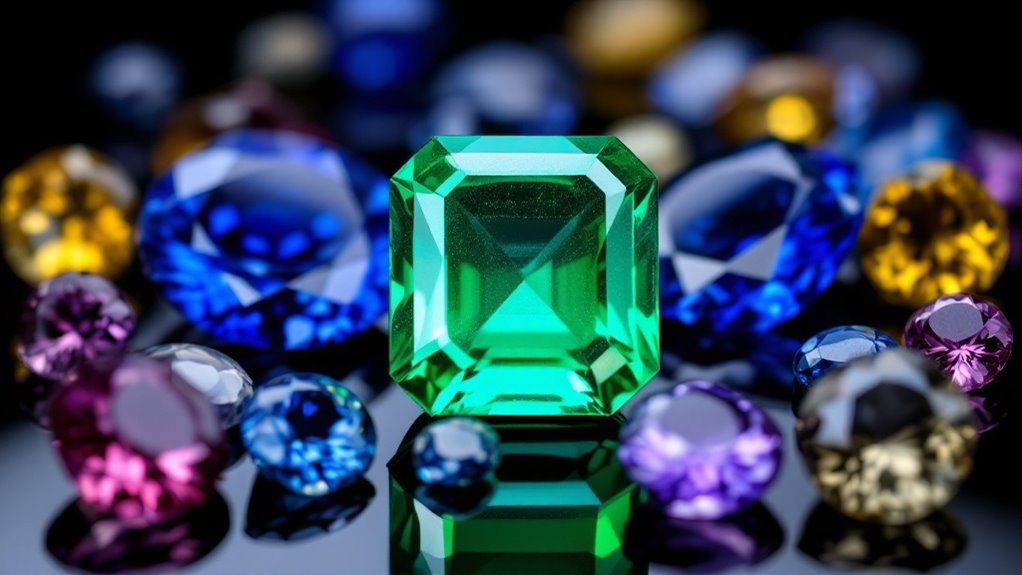Resin jewelry offers myriad opportunities by incorporating natural elements. Dried flowers, crushed opal, and seashells bring vibrant colors and textures. Glow-in-the-dark pigments, complemented with wood pieces and small branches, offer intriguing visual effects. Mixing crushed minerals or botanicals with clear resin creates stunning clarity. Glitter enhances natural beauty while layering different pigments adds depth and dimension. Each choice allows for personalized creativity. Explore further for detailed insights on integrating these elements into compelling designs.
Incorporating Dried Flowers and Leaves
Incorporating dried flowers and leaves into resin jewelry offers a unique way to blend natural beauty with artistic expression. Dried organic wildflowers, such as those from Etsy seller LuckyplantUS, provide vibrant materials for resin jewelry making. At prices ranging from $2.97 to $3.78, pressed flowers and leaves offer affordable and diverse color options. A collection of 100 pressed flowers, like white daisies for $12.57, guarantees ample supply for multiple projects. Preserved flowers in resin capture nature’s fleeting beauty, transforming it into lasting keepsakes. Proper cleaning and drying are crucial to maintain color integrity when these elements are encapsulated.
Using Crushed Opal for a Multicolored Effect
Crushed opal offers a vibrant palette when mixed, resulting in stunning multicolored effects for resin jewelry. By encapsulating these opal mixtures in resin, the colors remain vivid while being safeguarded from damage. Applying a glossy topcoat enhances the jewelry’s polished appearance and amplifies the natural shimmer of the opal.
Mixing Opal Colors
To create a striking multicolored effect in resin jewelry, a mix of crushed opal in varying hues such as blue, green, pink, and purple can be employed. This technique aligns with current resin jewelry trends, where vibrant, eye-catching designs are favored. For a uniform appearance, the crushed opal must be evenly distributed within the resin mixture, avoiding clumping. Utilizing clear resin allows the opal’s colors to radiate, offering stunning visual depth. After curing, a glossy topcoat amplifies the opal’s natural shimmer, ensuring a polished finish. Experimenting with different color ratios and combinations can yield unique patterns that reflect individual creativity.
Encapsulating With Resin
Building on the artistry of mixing opal colors, encapsulating these vibrant fragments within resin offers another dimension to resin jewelry making. The multicolored effect, achieved through the careful blending of crushed opal in resin, elevates the visual allure of jewelry pieces. Utilizing high-quality two-component epoxy resin guarantees peak clarity and durability.
For those interested in creating such pieces, consider these steps:
- Gather resin jewelry supplies, including molds and high-quality epoxy resin.
- Blend crushed opal into the resin, ensuring a uniform distribution before pouring.
- Allow curing, then incorporate hooks or attachments for easy transformation.
- Apply a glossy topcoat to protect and enhance the design.
Achieving Glossy Finish
Achieving a glossy finish in resin jewelry, particularly when incorporating crushed opal for a multicolored effect, requires meticulous attention to detail. Resin jewelry crafting tips suggest evenly mixing crushed opal with resin to enhance light reflection. Once poured into a mold, the mixture should cure fully according to the manufacturer’s guidelines. A clear resin topcoat can then be applied, amplifying the vibrancy and depth of the colors. Gentle sanding of edges with fine-grit sandpaper and polishing with a resin-friendly polish will achieve a high-gloss finish. A dust-free workspace is essential to avoid imperfections in the glossy topcoat.
Embedding Seashells and Sand for a Beach Vibe
When crafting resin jewelry that evokes the essence of the beach, embedding seashells and sand serves as an enchanting way to capture the ocean’s allure. Resin jewelry ideas flourish with this natural combination, providing wearers a chance to carry the sea’s charm with them. To create mesmerizing pieces, consider these steps:
- Seashell Selection: Choose various sizes and types for diversity in design.
- Sand Incorporation: Mix fine sand with shells to mimic the shoreline’s texture.
- Clear Resin Use: Utilize clear resin for transparency, highlighting intricate details.
- Glossy Topcoat Application: Add a glossy finish to resemble water’s reflective surface.
Adding Glow-in-the-Dark Elements for a Spooky Touch
For those looking to infuse a mysterious and eerie allure into their resin jewelry, adding glow-in-the-dark elements can create a mesmerizing effect. Incorporating high-quality glow-in-the-dark pigments into resin allows the pieces to emit a luminous glow, ideal for Halloween or night-time wear. To achieve the best results, mix the glow powder thoroughly with the resin to guarantee even distribution and avoid clumping. Experimenting with layering techniques can enhance the visual impact, placing glow elements beneath other designs for striking contrast. Adhering to proper curing conditions—considering temperature and light exposure—guarantees peak brightness and longevity of these natural elements for resin.
Utilizing Natural Wood Pieces in Designs
Incorporating natural wood pieces into resin jewelry requires careful selection of quality wood, such as olive wood, to guarantee unique textures and patterns enhance the designs. Proper integration involves drying and treating the wood to prevent moisture issues, allowing for a seamless blend with either colored or clear resin. Finishing techniques can further highlight the wood’s natural appeal, creating jewelry that resonates with both rustic charm and eco-conscious aesthetics.
Choosing Quality Wood Pieces
Selecting high-quality wood pieces is vital for creating exceptional resin jewelry designs. In diy resin jewelry, the right wood can enhance visual appeal and structural integrity. Consider these guidelines:
- Unique Textures and Patterns: Select wood with eye-catching textures and grain patterns to add depth.
- Proper Drying and Treatment: Confirm wood is thoroughly dried and treated to avoid moisture affecting resin curing.
- Grain Variety: Use woods like olive wood for their distinctive swirls and color variations.
- Resin Compatibility: Ascertain wood is free from oils or coatings for peak resin adhesion.
These steps guarantee the wood complements resin beautifully.
Integrating Wood With Resin
When integrating wood with resin in jewelry designs, the fusion of these materials offers a unique blend of nature and artistry. Natural wood pieces such as olive wood, known for their distinctive textures and patterns, are ideal for nature-inspired resin designs. Thoroughly drying and treating the wood is essential to prevent moisture from disrupting the curing process. Clear epoxy resin enhances the wood’s natural grain, creating a fascinating contrast with vibrant resin colors. This organic combination suits various occasions, appealing to diverse consumers. By experimenting with different wood types and shapes, artisans can craft innovative, one-of-a-kind jewelry pieces.
Finishing for Natural Appeal
The allure of natural wood pieces in resin jewelry lies in their ability to infuse designs with organic textures and warmth. This unique combination not only highlights the intrinsic beauty of botanical resin jewelry but also elevates its appeal through contrast and natural connection. Designers can creatively layer small wood slices or slabs within resin to add depth and visual interest. When selecting wood, varieties like olive or reclaimed wood enhance sustainability and character. To create striking pieces, consider:
- Layering wood slices in clear resin pendants.
- Utilizing olive wood for a rich, earthy tone.
- Combining wood with dried botanicals.
- Crafting rings with reclaimed wood accents.
Experimenting With Crystals and Minerals
Crystals and minerals offer a fascinating dimension to resin jewelry, transforming each piece into a unique work of art. In resin casting with natural materials, the use of crystals like amethyst, quartz, or citrine enhances the aesthetic appeal through their unique shapes and colors. These elements introduce not only visual allure but also metaphysical properties, providing personal significance to the wearer. By layering tiny crystal pieces, artisans can achieve a geode-inspired effect, imparting a luxurious appearance. Additionally, combining crushed minerals with resin adds texture and sparkle, creating designs that reflect light beautifully. Proper cleaning guarantees the crystals’ integrity during curing.
Integrating Twigs and Small Branches
Incorporating twigs and small branches into resin jewelry begins with selecting suitable pieces that are clean, dry, and possess interesting shapes or textures. Preserving the natural textures involves cutting the branches into manageable sizes that fit the mold while maintaining their unique characteristics. By designing unique arrangements with these elements, artisans can highlight the organic aesthetic and guarantee that the intricate details of the twigs remain prominent in the finished piece.
Selecting Suitable Branches
Selecting twigs and small branches for resin jewelry involves an artful balance between aesthetics and practicality. For nature-themed resin projects, one must consider several factors to guarantee the success of the piece:
- Dryness and Cleanliness: Choose branches that are dry, clean, and free from mold to prevent resin discoloration.
- Texture and Pattern: Opt for branches with unique textures or patterns for added visual interest.
- Size and Shape: Select thinner branches for delicate designs and thicker ones for bold focal points.
- Wood Type: Experiment with different wood types, like birch or pine, to find the best aesthetic and resin compatibility.
Preserving Natural Textures
When integrating twigs and small branches into resin jewelry, it is essential to preserve their natural textures to enhance the final piece’s aesthetic appeal. Thorough cleaning and drying of twigs prevent mold growth, ensuring a clear finish within floral resin jewelry. By experimenting with various sizes and shapes, one can create layered designs that add depth and visual interest. Incorporating additional elements, such as colored pigments or glitter, is a way to complement the natural wood textures. Adhering to proper resin mixing and curing techniques guarantees a smooth, durable finish, highlighting the innate beauty of the preserved natural elements.
Designing Unique Arrangements
Building on the concept of preserving natural textures, designing unique arrangements with twigs and small branches in resin jewelry invites creative exploration. This resin art with natural elements offers a rustic charm, capturing nature’s beauty. For successful integration:
- Preparation: Confirm twigs are thoroughly cleaned and dried, preventing moisture issues during resin curing.
- Arrangement: Experiment with orientations—parallel, crisscrossed, or spiraled—creating varied visual effects.
- Encapsulation: Use clear resin to highlight natural textures and colors, giving a glossy finish.
- Enhancement: Pair with complementary elements, such as pressed flowers or leaves, to harmonize with wood tones.
This method fosters unique, organic jewelry creations.
Layering Different Colored Pigments
How can artists achieve breathtaking depth in resin jewelry? By layering different colored pigments, they create stunning, eco-friendly resin crafts that fascinate with their depth and dimension. Starting with darker pigments at the base and shifting to lighter shades enhances the gradient effect, reminiscent of natural scenes like sunsets. Thorough mixing is essential to avoid clumping, ensuring clarity. By experimenting with transparent and opaque pigments, artists introduce complexity and bold accents.
| Technique | Result | Tip |
|---|---|---|
| Swirling | Unique patterns | Pour at varying heights |
| Dark to Light | Smooth gradient | Start with darker colors |
| Transparent | Depth and complexity | Mix pigments thoroughly |
| Opaque | Bold accents | Use for striking contrasts |
| Layering | Fascinating designs | Mimic natural phenomena |
These techniques yield one-of-a-kind creations.
Crafting With Pressed Botanical Elements
Incorporating pressed botanical elements into resin jewelry captures the essence of nature, transforming each piece into a miniature work of art. Handmade resin accessories benefit from the natural beauty of dried flowers and leaves, readily sourced from suppliers. To create visually stunning pieces, consider these steps:
- Ensure thorough drying: Prevent discoloration or mold by using moisture-free botanicals.
- Layer for depth: Combine various botanicals to enhance dimension and appeal.
- Use clear molds: Maximize visibility and showcase intricate details.
- Polish the final piece: Enhance clarity and shine, making botanicals appear vibrant.
These techniques highlight nature’s allure in resin jewelry.
Combining Glitter With Natural Materials
Expanding on the beauty of pressed botanical elements, the addition of glitter introduces a new dimension to resin jewelry, infusing pieces with an enchanting sparkle. This combination enhances visual appeal, contrasting beautifully with organic elements like dried flowers and leaves. According to resin jewelry tutorials, fine glitter can be mixed into the resin for even distribution, while larger flakes create a layered effect when sprinkled on top. Using biodegradable glitter is recommended for eco-friendliness. Experimenting with color combinations allows for creative, personalized designs. Proper mixing of glitter guarantees a professional finish, avoiding clumps and guaranteeing even curing.
Conclusion
In exploring the diverse possibilities of resin jewelry, natural elements offer endless creativity. Dried flowers and leaves lend an organic elegance, while crushed opal creates a vibrant, multicolored effect. For those drawn to the ocean, embedding seashells and sand captures a beachy essence. Glow-in-the-dark elements add a mystical touch, and natural wood pieces provide rustic charm. By incorporating twigs, colored pigments, pressed botanicals, and glitter, artisans can craft unique pieces that blend nature with artistic expression.





Leave a Reply